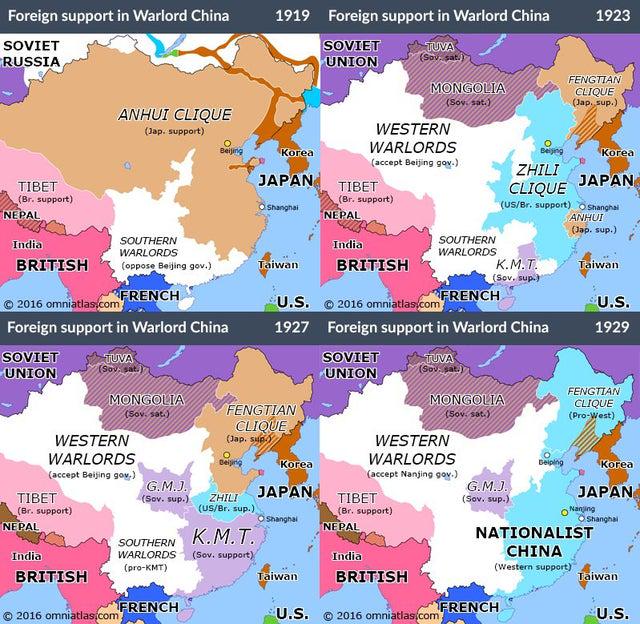Phases of the Chinese Warlord Era Map


David Chen
Data Visualization Specialist
David Chen is an expert in transforming complex geographic datasets into compelling visual narratives. He combines his background in computer science ...
Geographic Analysis
What This Map Shows
The "Phases of the Chinese Warlord Era Map" provides a comprehensive visualization of the tumultuous period in Chinese history from 1916 to 1928, highlighting the various factions and territories controlled by warlords during this time. This map allows viewers to understand the complex geopolitical landscape of China in the early 20th century, illustrating how fragmented the nation became following the fall of the Qing Dynasty and the power vacuum that ensued. The map segments China into different regions, each marked by the influence and control of various warlords, making it a valuable tool for understanding not just geography, but also the socio-political dynamics of the era.
Deep Dive into the Warlord Era
The Warlord Era, also known as the Beiyang Government period, was characterized by the fragmentation of central authority in China. Following the Xinhai Revolution of 1911, which led to the overthrow of the Qing Dynasty, the nation entered a phase of disarray. Regional military leaders, known as warlords, seized control over various territories, leading to a lack of cohesive governance. Ever wondered how these warlords came to power? Their rise was primarily due to the weakening of the central government and the disillusionment of military officials who had gained substantial autonomy.
What's fascinating is that these warlords were not just local leaders; many had significant military might, political influence, and economic control. They operated independently, often clashing with each other and forming temporary alliances. The period is marked by notable figures such as Yuan Shikai, who initially attempted to unify China under his rule but eventually succumbed to the same fragmentation he sought to eliminate. This led to a patchwork of competing factions, each with its own loyalties and objectives.
The warlords controlled various resources, including railways, agricultural lands, and trade routes, which they used to strengthen their power. For instance, the warlords in the northeast, such as Zhang Zuolin, capitalized on their control over the rich agricultural land and coal mines in Manchuria. Meanwhile, warlords in the south, like Sun Yat-sen's followers, focused on garnering support from revolutionary factions and urban centers.
This decentralized power structure not only hampered economic development but also led to widespread violence and civil strife. The warlord armies frequently engaged in conflicts, further destabilizing the nation. By the mid-1920s, the situation became untenable, prompting the Nationalist Party (Kuomintang) to launch the Northern Expedition in 1926, aiming to unify the country by defeating the warlords. This military campaign was a significant turning point, ultimately leading to the consolidation of power under the Nationalist government and the decline of warlord rule.
Regional Analysis
Analyzing the map reveals distinct regional dynamics that characterized the Warlord Era. In the north, warlords like Zhang Zuolin and Feng Yuxiang dominated, with their territories extending across Manchuria and into parts of Inner Mongolia. Interestingly, their influence was bolstered by foreign powers, particularly Japan, which had vested interests in the region following its victory in the First Sino-Japanese War.
In contrast, the south was marked by a different set of warlords, such as Chen Jiongming and Li Zongren, who often had varying loyalties and objectives. The southern provinces were also more influenced by revolutionary sentiments, leading to frequent conflicts with the Nationalist forces. The map clearly shows how these competing interests shaped not only military outcomes but also the cultural and economic landscapes of their respective regions.
Central China was a battleground where various factions vied for control, often leading to shifting alliances and betrayals. The map illustrates how quickly territorial control could change hands, reflecting the fluid nature of power during this chaotic period.
Significance and Impact
Understanding the phases of the Chinese Warlord Era is crucial for comprehending modern Chinese history. The fragmentation and conflict of this period laid the groundwork for the eventual rise of the Chinese Communist Party and the establishment of the People's Republic of China in 1949. The legacy of warlordism still resonates today, as many regions in China have retained cultural and economic characteristics that trace back to this tumultuous time.
Moreover, the Warlord Era serves as a poignant reminder of the challenges of governance and the impact of regionalism on national unity. Current trends in China, including debates over regional autonomy and local governance, echo the historical struggles faced during the warlord period. Furthermore, analyzing this era offers insights into how power can shift and the long-term effects of political fragmentation on societal cohesion.
In conclusion, the "Phases of the Chinese Warlord Era Map" is not just a historical artifact; it is a vital resource for understanding the complexities of Chinese politics and society during a time of unprecedented change. As we reflect on this fragmented past, it becomes evident that the pathways of history are often paved with conflict and power struggles, shaping the world we know today.
Visualization Details
- Published
- October 14, 2025
- Views
- 36
Comments
Loading comments...